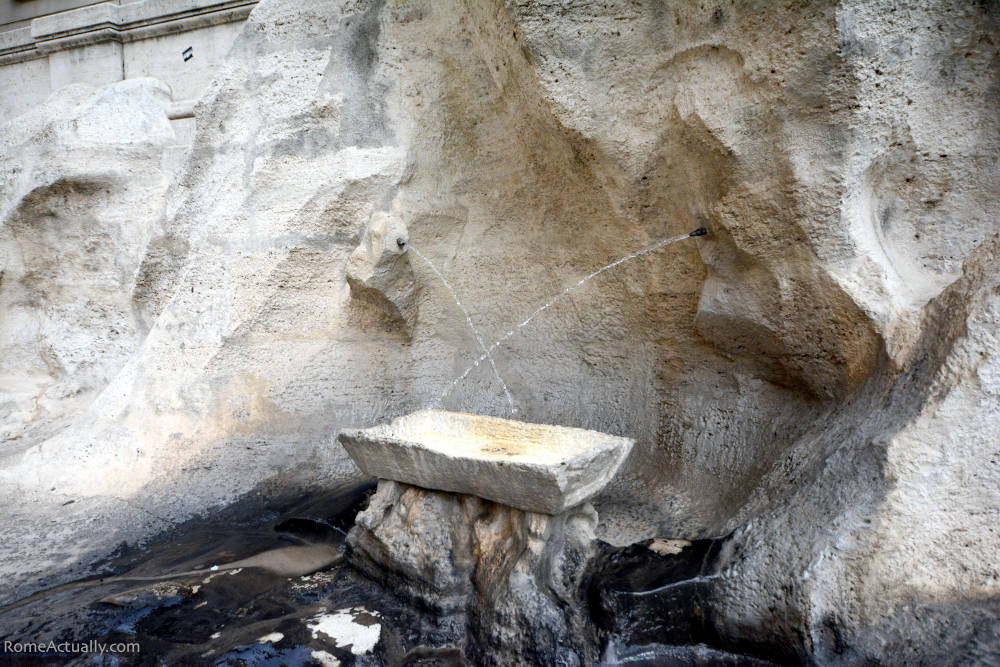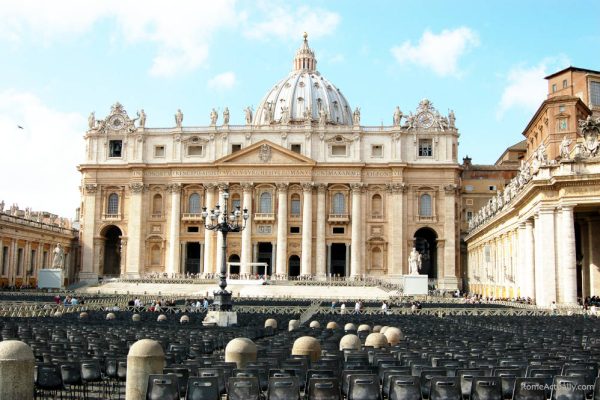The city of Rome has had a special relationship with water from the very beginning of its history. It’s not a case, in fact, that on your way into the city driving to Rome, whether it’s from north or south of the city, you can spot the vestiges of the ancient aqueducts.
If you are wondering whether you can or cannot drink tap water in Rome, where to find safe drinking water, and where the water you are served in public spaces comes from, you are in the right place. This quick guide on Rome’s tap water will help you throughout your vacation and will tell you exactly how and where to drink water like a local.

Is it safe to drink tap water in Rome?
Whenever I recommend items that should be packed for Rome, a reusable travel bottle is always included. This is precisely because Rome’s tap water is perfectly safe to drink.
Romans have provided the city with clean water for over 2000 years and they are still doing it to provide for the almost 3 million citizens, some 15 million tourists every year, and the local restaurants, bars, and hotels.
The access and safety standards of the tap water in Rome are under the responsibility of ACEA. Rome receives 97% of its drinking water from springs and 3% from wells, while the entire water supply in Rome comes 85% from springs, 12% from wells, and 3% from surface sources. Rome tap water is considered to be very high-quality.
The main pipeline system currently bringing water to Rome is the Peschiera-Capore aqueduct, which conveys the waters of the springs of the Peschiera river and of Le Capore in the Rieti province. With about 130 km of pipelines, the Peschiera-Capore is one of the largest spring aqueducts in Europe and in the world. Around 90% of the aqueduct runs underground.

For more than 80 years, it has guaranteed around 85% of the water needs of Rome, of many municipalities in the Rieti area, in the Bassa Sabina and on the northern coast of the Lazio region from Fiumicino to Civitavecchia.
Another pipeline system bringing water to Rome is the Aqua Marcia, but not the ancient one, a new system that is undergoing expansion with the aim of increasing its safety and sustainability.
Rome tap water is considered one with the highest quality in Europe, yet most Romans consume bottled water even at home. Why is that? Because the tap water in Rome is “hard”, also known as calcareous water.
This means that it’s rich in minerals, especially calcium and magnesium, and it’s what makes many people think that it’s bad for our kidneys. However, recent studies have shown that there is not such a danger. The minerals, actually, can have a positive impact on the human body such as the cardiovascular system, the intestine, and for the health of the bones.
Where can you drink tap water in Rome?
So, now that we have straightened this out, let’s get practical and understand how you can actually source tap water in Rome. This will make you save plenty of money during your trip and you will notice especially if you are spending no less than a week in Rome.
Bars
Usually, when asking for a glass of water at a bar in Rome, you will receive tap water. This is the case also when you order a coffee and they bring it to you your table together with a small glass of water.
Of course, you can ask for bottled water (acqua minerale), and they will sell you a half-a-liter water bottle, still or sparkling.
Nasoni
The famous nasoni are those little fountains with a tap where water usually flows constantly and uninterrupted day and night. Rome’s nasoni are usually made in cast iron, but it’s possible to find some in travertine. The water flows non-stop and is always quite cold, summer and winter.
All around Rome, there are around 2500 nasoni gushing out drinking water. Here is ACEA’s easy map of where to find the nasoni all over Rome. You can type the street where you are and the closest fountain of drinkable water will appear.
Apart from the cylinder-shaped nasoni, there are also some 90 little artistic fountains dispensing drinking water in Rome’s Centro Storico. Some of the most famous ones include the one built into the wall in Via della Fontanella Borghese and the dragon-shaped one near Via Nazionale, one of Rome’s most famous streets.

Case dell’Acqua (Water houses)
Recently, ACEA has installed several “Case dell’Acqua” throughout Rome’s territory. These are hi-tech little fountains where you can drink still or sparkling tap water while you are charging your smartphone or tablet.
You can find a list of ACEA’s water houses here and you can also type your address to see where is the nearest one located.
Hotels
The tap water you will find in your Rome hotel room is as safe to drink as the rest of the tap water in the city, in private homes, and in bars. You can use it to refill your reusable bottle to carry around during your sightseeing.
Homes
If you are renting an apartment in Rome, you can rest assured that you can safely drink tap water and use it to refill your reusable bottle. If you let Rome tap water flow for a few seconds, you will notice that it starts becoming quite cold, almost fridge temperature. In summer, this is very refreshing, in winter, it freezes my hands when I open only cold water to wash.

Water in ancient Rome – Some history
Water in Rome has always played a pivotal role in its society and its development as the capital of a fast-sprawling empire. One of the first things, in fact, that Rome’s rulers did when the city started to expand has been to find a way to provide the citizens with fresh drinkable water from the springs around the region.
This is how the first aqueducts came to be, starting with the Aqua Appia in 312 BC, ordered by Roman statesman Appius Claudius Caecus, the same who built the Appian Way, one of the most famous roads in Italy.
The sophisticated engineering skills behind the city’s ancient aqueducts are one of the things that have made Rome famous for millennia.
The importance of these imposing structures, however, goes beyond the technical aspects. They were pivotal in ensuring free drinking water to the population, supplying clean water to the public baths as well as the private thermal centers of senators and wealthy families, and providing service water to the citizens for all their daily chores.
Throughout the centuries, in fact, Rome has always been rich in public fountains scattered around the city, often displaying the crest of the ruler or pope which made them build and used them as a reason to boost their prestige and reputation among the population.
As history goes, the only way vandals managed to conquer Rome was “by thirst”, so severing its aqueducts. This shows how much Romans were the first civilization to understand the value of providing free clean water to all the citizens, no matter what their social rank was.

Tap water vs bottled water in Rome restaurants
As soon as you are allocated your table at a restaurant in Rome, a waiter will ask you if he can bring you water first thing. If they ask you directly if you prefer still or sparkling, they are likely to bring you their own filtered tap water in a glass bottle that shows no brand or only the name of the restaurant.
On the other hand, if they ask you what they can bring you to drink and you ask for water, this will likely be mineral water, and they will bring it to your table sealed.
Depending on the restaurant, filtered tap water is either free or very cheap, while a liter of mineral water can be priced from 2€ on.
Which bottled water to choose?
If you are buying a bottle of water in Rome, there are many brands you can choose from. In restaurants, you will often find Ferrarelle for both sparkling and still water. As for sparkling water, I prefer Nepi as it’s lighter than Ferrarelle.
In small convenience stores and larger food shops, you will have a much wider choice. Some of the most popular brands for bottled water include the above-mentioned Ferrarelle, Sant’Anna, Fabia, Vitasnella, Rocchetta, Levissima, San Benedetto, Sangemini, Acqua Lete, Acqua Panna, and Egeria. For good sparkling water, you can opt for Uliveto.
Can you drink water from Rome’s fountains?
As mentioned earlier, you can drink Rome’s tap water flowing from the nasoni small fountains. But that’s all.
Rome is studded with beautiful fountains like the Trevi Fountain or the Four Rivers Fountain in Piazza Navona, but their water is non-drinkable. Not only do people keep touching it or throwing coins in it like in Trevi, but there is a system in place of recycling and re-circulating the same water that makes it not safe for drinking.
For example, the water of the Trevi Fountain is the same every day. It gets checked out, purified, and put back into circulation on a daily basis.

Drinking water in Rome – Handy glossary
Here are some useful terms you might need when traveling in Italy and ordering water at a restaurant or buying it from a shop.
- Drinkable water >> Acqua potabile
- Non-drinkable water >> Acqua non potabile
- Still water >> Acqua liscia
- Sparkling water >> Acqua frizzante
- Slightly sparkling water >> Acqua leggermente frizzante
- A glass of water >> Un bicchiere d’acqua
- A bottle of water >> Una bottiglia d’acqua
- Bottled water >> Acqua in bottiglia
- Mineral water >> Acqua minerale
- With ice >> Con ghiaccio
- Room temperature >> A temperatura ambiente





Vielen Dank, liebe Angela! Das ist eine großartige Reiseunterstützung, wunderbar logisch, praktisch und effizient geschrieben. Ich werde ab Mitte April 2 Monate in Rom einen selbst organisierten Aufenthalt machen, da ich mich immer schon für das antike und barocke Rom interessierte. Dein Blog “Rome actually” ist toll! Meine Hochachtung! ich hoffe ich höre noch viel von dir und wünsche dir alles Gute! Ich freue mich auch schon riesig auf meine Reise!
Andrea, Wien